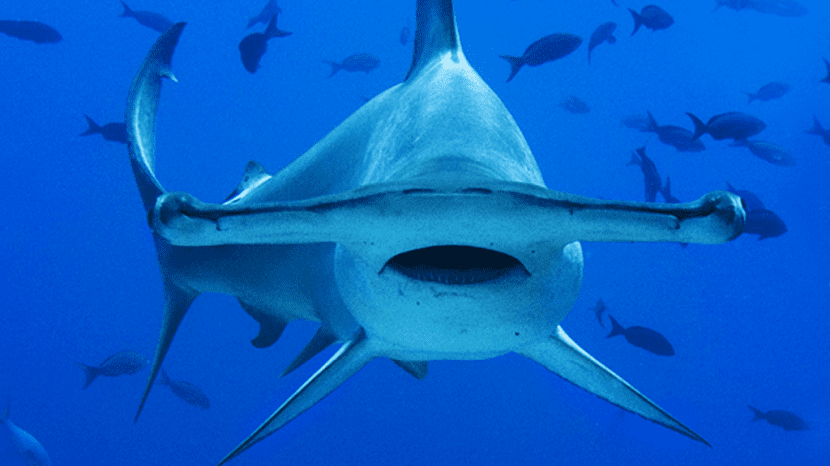
One of the most important predators in marine waters is the shark. There are numerous species of shark around the world. There are those who are more docile and less dangerous and there are those who are dangerous for humans and any marine species that comes close to it. In this case, we are going to talk about hammerhead shark. Its role as a predator is important because it plays a fundamental role in the control of various populations in marine ecosystems.
In this article, you will learn everything about the hammerhead shark, from its main characteristics to how it feeds and how it reproduces.
Key features
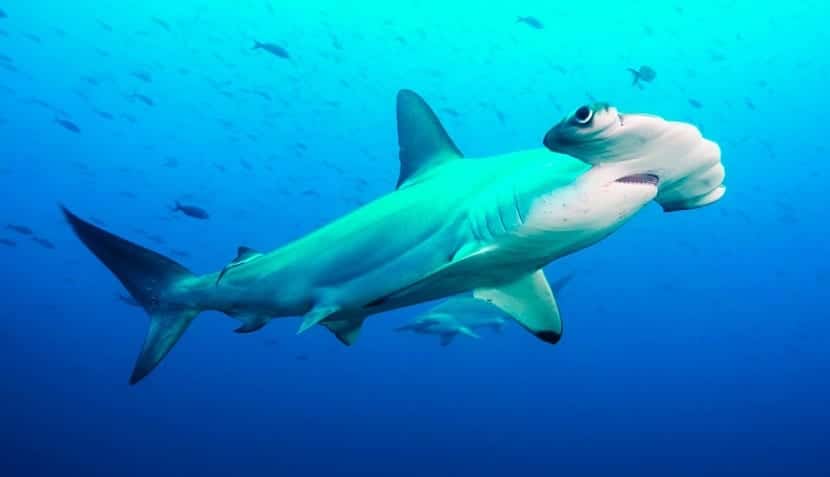
This shark is also known by other common names such as giant horned. Its scientific name is Sphyrna mokarran. It belongs to the Sphyrnidae family. Among the most striking characteristics of this shark we find its T-shaped head. This is the reason why this fish is known as a hammerhead shark. If we evaluate the complete body of this shark, we will realize that it is shaped like a hammer. We could say that the whole body is the handle by which we take it. The T-shaped head ends up being the metal part with which we drive the nails.
This T-shaped head not only gives you what has been a different visual feature. Thanks to this peculiar shape, This shark is capable of 360-degree vision. As you can imagine, this type of characteristic brings a great improvement to its sensory abilities and its talent to hunt and act as a predator.
It is a fairly large animal with an average size of 3,5 to 4 meters. In some areas, individuals up to 6 meters in length have been found. This varies greatly in the composition of the body, the ecosystem where it develops, the amount of food available, its motor capacity, etc.
The T-shaped head helps you improve your vision and, due to its adaptation in the marine environment, it can also turn your body quickly. For an animal with such dimensions, changing direction and direction in the face of the pursuit of its prey is more complicated. Given this, the T-shaped head serves to anticipate the movements of the prey and end up modifying its direction and sense with greater speed.
Distinction from other sharks
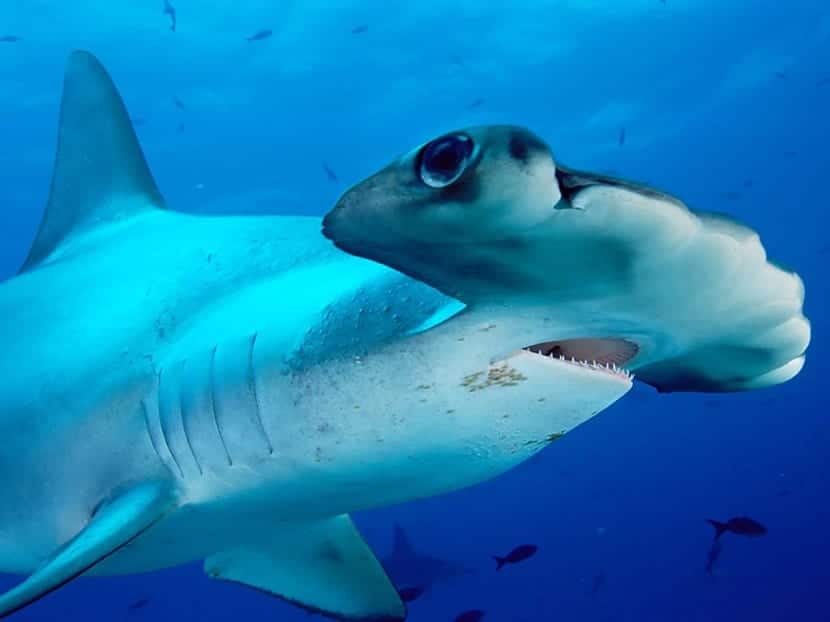
They are really impressive animals. It is said that the White shark It is the most feared and known to all. However, the hammerhead shark has some peculiarities that make it special. They have a development of 7 senses enormously. Not only do they have the senses that we know in the human being, but they have two more. One is used to distinguish frequency waves and the other to detect the electric field produced by other fish. These two new senses are very useful to them when looking for and capturing prey. It is useless that they hide behind some rocks, the hammerhead shark will be able to detect them with these two highly developed senses.
The mouth of this animal is located in the lower part of the head. Its mouth is not large enough to capture large prey, but yes it has tremendously sharp teeth to tear better. Thanks to the sharp teeth it has a catch rate with a higher probability of success.
As for the color, it is light gray to green and this allows it to be confused at the bottom of the sea so as not to be detected. The ventral part is lighter in color than the rest.
Behavior and habitat
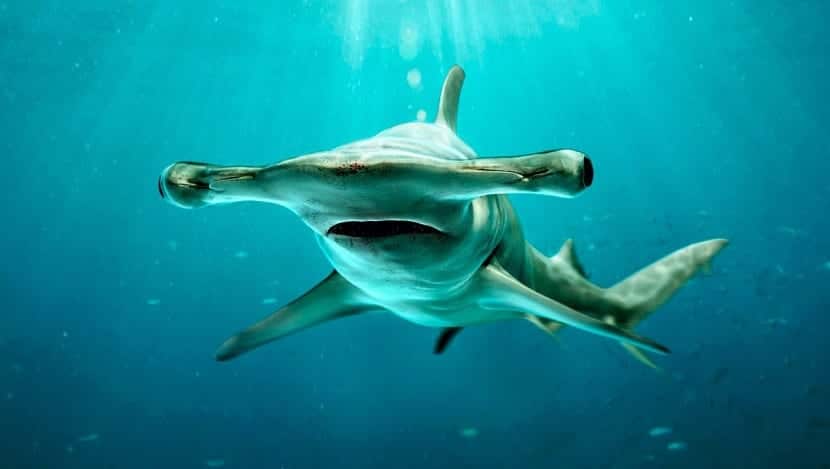
During the day it is usually seen forming some groups of quite a few specimens. When they are in large groups they do not usually hunt much since they cannot camouflage themselves or hide. Being so many specimens and having such a large size, it is difficult to go unnoticed among the rest of the prey.
At night is another story. This is where they usually have the best hunting times., since they move alone. Some specimens have a more docile and harmless behavior than others. Normally, depending on their size, they are more or less aggressive. Larger hammerhead sharks have the most dangerous attacks and the most aggressiveness. Their life expectancy is usually around 30 years in freedom. This life expectancy is subject to the possible dangers it has if they are captured by humans or treated in captivity.
Regarding its habitat, although it is in danger of extinction according to IUCN data, we can find it almost all over the world. Its abundance is greater in areas whose waters are tropical and temperate. They do not prefer the cold, try to avoid it. The area of greatest activity is the one close to the coasts. The depth of the waters in which they swim is less than 280 meters.
They generally swim in calm waters. Geographically, we find the largest hammerhead shark populations in the Indian Ocean, the Galapagos Islands and Costa Rica.
Feeding and reproduction
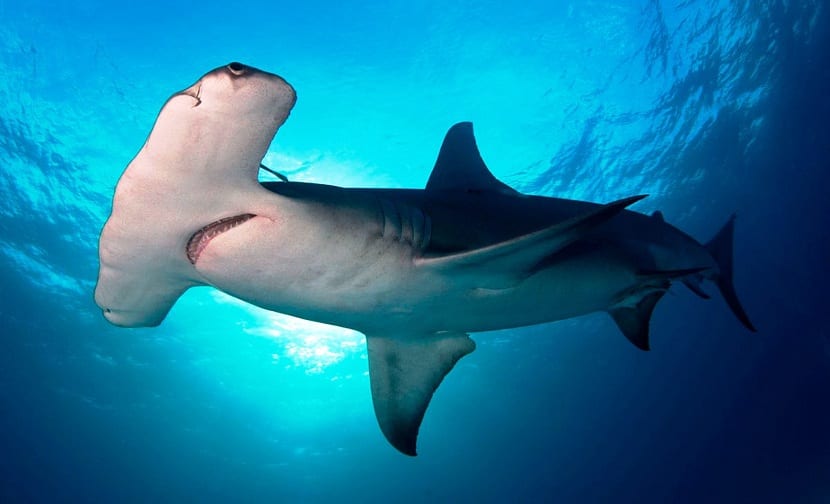
Like most sharks, it is a carnivorous animal. The diet is mainly made up of fish, squid, eels, dolphins, crabs, snails and their favorite delicacy which are rays.
The fame of being a great predator has been acquired for its ability to capture animals easily. However, they do not eat human beings nor should you think that you are in danger if you come across one of them.
The hammerhead shark lunges at its prey and it uses its head to strike and weaken its prey.
Being more solitary animals, reproduction does not occur as often. It is a viviparous species. It reproduces every two years once they have reached sexual reproduction. The number of young usually varies depending on the size of the female. The gestation period usually lasts about 10 months.
I hope that with this information you can learn more about the hammerhead shark and its main characteristics.